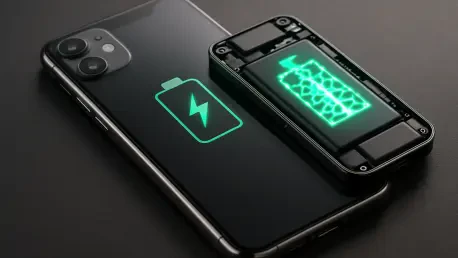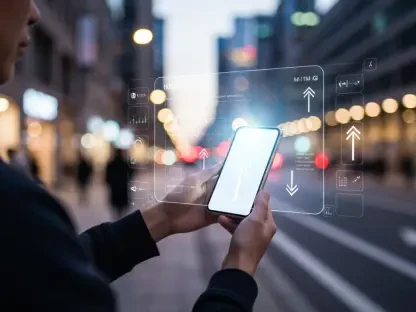In an age where smartphones are indispensable for everything from work to entertainment, battery life remains a critical concern for millions of users worldwide, often dictating the choice of device in a crowded market. Apple has long been at the forefront of mobile technology, yet the challenge of balancing power-hungry features with enduring battery performance has persisted. With the introduction of iOS 26 and the upcoming iPhone 17 lineup, the tech giant appears poised to tackle this issue head-on. This latest software update brings a suite of innovative battery management tools designed to work in tandem with rumored hardware advancements, promising a significant leap in how users experience and manage power on their devices. As anticipation builds for the new release, the focus shifts to how these enhancements could redefine expectations for smartphone endurance and set a new standard in the industry.
Software Innovations in Power Management
Unveiling a Smarter Battery Interface
Apple’s latest software update introduces a revamped Battery settings interface that offers users unprecedented visibility into their device’s power consumption patterns. This feature provides detailed breakdowns of which apps and processes are drawing the most energy, empowering users to make informed decisions about their usage. Unlike previous iterations, the interface now includes actionable insights, such as suggestions to limit background activity for specific applications. This granular control marks a significant step forward in helping users mitigate unnecessary drain, especially during extended periods of use. Moreover, the design is intuitive, ensuring that even those less tech-savvy can navigate and optimize their settings with ease. By placing such detailed diagnostics at users’ fingertips, Apple aims to address one of the most common frustrations in mobile technology, potentially reducing the frequency of low-battery stress in daily routines.
Beyond mere visibility, this updated interface serves as a bridge between user behavior and device efficiency, fostering a more proactive approach to power management. Reports indicate that iOS 26 can highlight trends over time, allowing users to identify recurring issues with certain apps or settings that might otherwise go unnoticed. This data-driven perspective not only helps in immediate troubleshooting but also educates users on how their habits impact battery life. For instance, excessive screen brightness or constant location tracking can be flagged for adjustment, leading to tangible savings in power. As the software rolls out alongside the anticipated hardware, the synergy between detailed feedback and user action could create a more seamless experience, ensuring that battery concerns become less of a barrier to enjoying the full capabilities of modern smartphones.
Adaptive Power Mode: A Game-Changer
One of the standout features in iOS 26 is the introduction of Adaptive Power Mode, a sophisticated evolution of the familiar Low Power Mode. Utilizing machine learning, this feature analyzes individual usage patterns to predict when power conservation is most needed, dynamically adjusting performance without sacrificing essential functionality. Unlike its predecessor, which often required manual activation, this mode operates in the background, fine-tuning aspects like CPU speed and refresh rates based on real-time demands. Early feedback from beta testers suggests that it excels in scenarios involving heavy multitasking or prolonged screen time, preserving battery life during critical moments. Tailored for newer devices, this innovation hints at a close integration with the rumored hardware upgrades expected in the next flagship model.
The potential of Adaptive Power Mode extends beyond individual convenience, possibly influencing how users interact with their devices on a fundamental level. By automating power-saving decisions, it reduces the cognitive load on users who might otherwise forget to toggle settings during busy days. This intelligent adjustment could be particularly beneficial for professionals relying on their phones for extended video calls or navigation, where uninterrupted performance is crucial. Furthermore, speculation surrounds its compatibility with a larger battery capacity rumored for the iPhone 17 Pro Max, suggesting that the mode could unlock even greater endurance for power-intensive tasks like 8K video recording. As Apple pushes the boundaries of what automated power management can achieve, this feature might well become a benchmark for competitors striving to match similar levels of efficiency.
Hardware and Software Synergy for Battery Longevity
Optimizing Charging for Durability
A key focus in iOS 26 is enhancing battery health through smarter charging optimizations, designed to minimize wear over time. Features like limits on overnight charging prevent the battery from remaining at full capacity for extended periods, a practice known to accelerate degradation. This software tweak works alongside whispers of advanced thermal management systems, such as vapor chambers, expected in the upcoming iPhone 17 series. Together, these elements aim to maintain optimal battery conditions even under heavy use. Additionally, a subtle low-battery animation in the beta version serves as a gentle nudge to plug in before reaching critical levels, further protecting long-term health. This thoughtful integration reflects a comprehensive strategy to extend the lifespan of device power sources.
Beyond immediate protections, these charging optimizations signal Apple’s commitment to sustainability and user trust in device reliability. By reducing stress on the battery through controlled charging cycles, the software helps ensure that devices remain functional for longer periods, potentially decreasing the need for frequent replacements. This approach aligns with broader industry trends toward eco-conscious design, where longevity is as critical as performance. Rumors of improved cooling mechanisms in the hardware suggest that heat—a notorious enemy of battery health—will be better managed, complementing the software’s efforts. As users increasingly demand devices that stand the test of time, such innovations could position Apple as a leader in delivering not just cutting-edge technology, but also enduring value in everyday use.
Strategic Market Positioning with Enhanced Features
Apple’s approach with iOS 26 and the iPhone 17 also reveals a calculated move to stand out in a competitive landscape where rivals often tout larger battery capacities. By restricting advanced features like Adaptive Power Mode to newer models, there’s a clear incentive for users to upgrade, potentially driving sales while reinforcing the brand’s premium image. The revamped Battery screen simplifies troubleshooting, which could lead to fewer support queries and higher user satisfaction—a vital component of customer retention. This strategy of pairing software updates with hardware launches has long been a hallmark of Apple’s ecosystem, ensuring that each release feels like a cohesive step forward. The timing of the software rollout, expected to align with the device debut, amplifies this effect, creating buzz and anticipation.
From a broader market perspective, these advancements carry implications for how Apple navigates device fragmentation and user expectations. While older models may miss out on the full range of benefits, proponents argue that this drives innovation by focusing resources on cutting-edge technology. Critics, however, point to potential dissatisfaction among users of legacy devices, highlighting a delicate balance between progress and inclusivity. Nevertheless, the emphasis on detailed diagnostics in iOS 26 could encourage developers to prioritize battery-efficient coding, fostering an ecosystem where efficiency is paramount. As Apple aims to reclaim dominance in mobile endurance, these combined efforts might not only influence industry standards but also reshape consumer perceptions of what a premium smartphone experience entails.
Reflecting on a Powerhouse Partnership
Looking back, Apple’s integration of iOS 26 with the iPhone 17 marked a pivotal moment in addressing longstanding user concerns about battery performance. The collaboration between advanced software tools and rumored hardware upgrades demonstrated a nuanced understanding of modern mobile needs. Features like Adaptive Power Mode and optimized charging cycles showcased how far technology had come in balancing power with efficiency. Moving forward, the industry will likely keep a close eye on adoption trends and user feedback to assess the real-world impact of these innovations. For users, the next steps involve exploring these tools to maximize device potential, while developers might consider leveraging diagnostic insights to refine app performance. As Apple continued to set benchmarks in smartphone endurance, the focus remained on evolving these features to meet future demands, ensuring that battery life no longer stood as a barrier to seamless mobile experiences.









